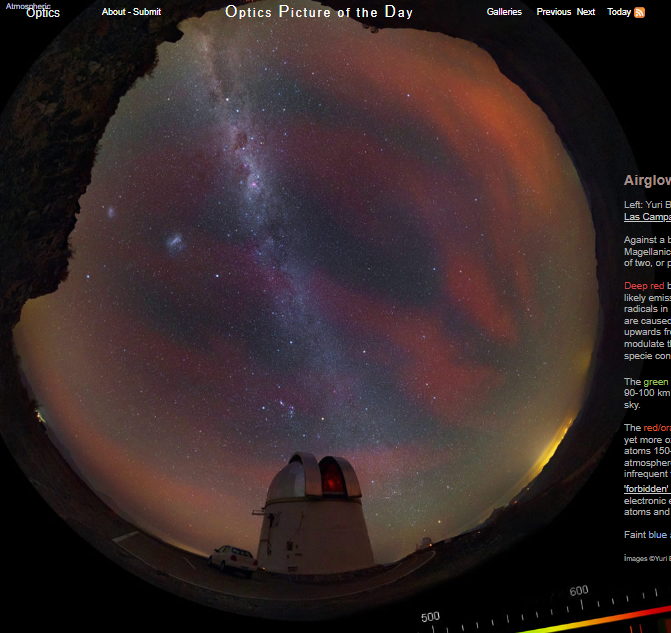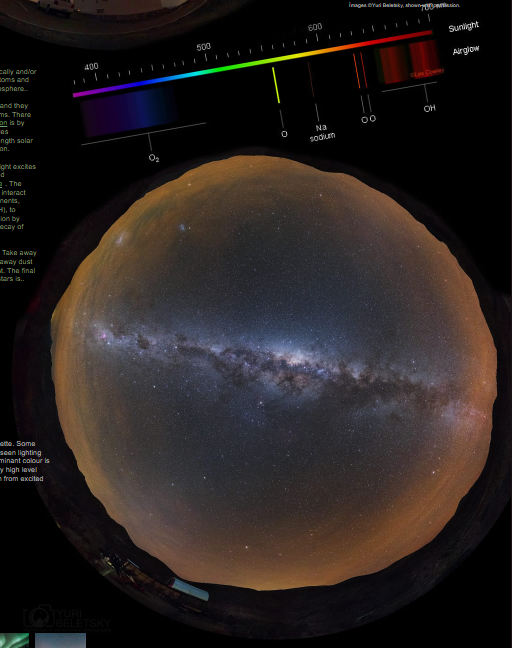Airglow colours - OPOD
Airglow Colours: A Fascinating Phenomenon in the Night Sky
Have you ever looked up at the night sky and noticed a subtle glow of colors, seemingly emanating from the atmosphere itself? This captivating phenomenon is known as airglow. While it may not be as dazzling as the Northern Lights or as prominent as the stars, airglow adds a touch of enchantment to our nocturnal sky. In this article, we will delve into the mesmerizing world of airglow colors, exploring their origins, composition, and the intricate processes that give rise to these ethereal hues.
Unveiling the Colors of Airglow
Airglow presents itself in a myriad of colors, each offering a unique spectacle to behold. Let's take a closer look at some of the most prominent airglow colors:
-
Deep Red Banded Airglow: Spanning the sky with its vibrant red bands, this particular airglow arises from vibrationally excited OH radicals in a layer approximately 86 kilometers above the Earth's surface. Gravity waves propagate upwards from the lower atmosphere, modulating local pressure, temperature, and species concentrations, giving birth to these captivating red bands.
-
Green Airglow: Patches of green airglow can be observed in the closer horizon sky. This green hue originates from oxygen atoms (1S -> 1D) located at altitudes ranging from 90 to 100 kilometers. These atoms become electronically excited and subsequently emit green light, adding a touch of enchantment to the nocturnal canvas.
-
Red/Orange Airglow: At times, a mesmerizing red/orange patch can be seen in the upper right corner of the sky. This hue also stems from oxygen airglow, but this time from atoms situated at much higher altitudes of 150 to 300 kilometers. In this rarefied atmosphere, collisions between atoms and molecules are infrequent, allowing the oxygen atoms ample time to radiate "forbidden" light (1D -> 3P) before losing their electronic excitation.
-
Faint Blue Airglow: While less common, a delicate blue airglow occasionally graces the night sky. The origins of this ethereal hue are still being investigated, but it is believed to arise from various atmospheric processes and interactions.
The Intricacies of Airglow Formation
Airglow is a result of the electronic and/or vibration-rotational excitation of atoms and molecules in the Earth's upper atmosphere. These atoms and molecules become energized through various mechanisms, leading to the emission of light. Here are some key points to understand about the formation of airglow:
-
Solar Excitation: The sun's extreme ultraviolet light plays a crucial role in exciting oxygen and nitrogen atoms and molecules in the thermosphere. This excitation occurs due to the absorption of short-wavelength solar radiation during daylight hours.
-
Chemiluminescence and Collisions: Once the atoms and molecules in the upper atmosphere become excited, they collide and interact with other atmospheric components, including hydroxyl radicals (OH). These interactions eventually give rise to light emission through a process known as chemiluminescence. Additionally, the decay of excited atoms and molecules contributes to the overall airglow phenomenon.
The Subtle Nature of Airglow
Airglow is an inherently subtle phenomenon. Its presence can only be fully appreciated when artificial light pollution, dust, haze, and even moonlight are minimized or absent. Airglow acts as the final barrier between a sky illuminated solely by stars and complete darkness. It adds a touch of mystique to the night sky, reminding us of the intricate interplay between Earth's atmosphere and the cosmos.
In conclusion, airglow colors paint a mesmerizing picture in our nocturnal sky, illuminating the atmosphere with their ethereal beauty. From the deep red banded airglow to the delicate blue hues, each color tells a story of atmospheric processes, electronic excitation, and rarefied altitudes. Next time you find yourself gazing at the stars, take a moment to appreciate the enchanting dance of airglow colors that adorn our celestial canvas.

Airglows of many colours
Left: Yuri Beletsky imaged this at Carnegie Las Campanas Observatory, Chile.
Against a backdrop of the galaxy, two Magellanic Clouds and Orion there is airglow of two, or possibly three, colours.
Deep red banded airglow spans the sky. It is likely emission from vibrationally excited OH radicals in a layer ~86km high. The bands are caused by gravity waves propagating upwards from the lower atmosphere. They modulate the local pressure, temperature and specie concentrations.
The green airglow of oxygen atoms (1S ->1D) 90-100 km high patches the closer horizon sky.
The red/orange patch at top right could be yet more oxygen airglow, this time from atoms 150-300km high where the atmosphere is so sparse and collisions so infrequent that the atoms have time to radiate 'forbidden' light (1D ->3P) before losing their electronic excitation in impacts with other atoms and molecules.
Faint blue airglow is sometimes seen.
images ©Yuri Beletsky, shown with permission.

A different airglow palette. Some green airglow can be seen lighting the sky but the predominant colour is a red/orange, probably high level (150-300km) radiation from excited oxygen atoms
Airglow is the light of electronically and/or vibration-rotationally excited atoms and molecules high in Earth's atmosphere..
Aurorae are at similar heights and they too are the light of excited atoms. There is a difference, auroral excitation is by collisions with energetic particles whereas daytime short wavelength solar radiation produces the excitation.
The sun’s extreme ultraviolet light excites oxygen and nitrogen atoms and molecules in the thermosphere.. The energetic products collide and interact with other atmospheric components, including hydroxyl radicals (OH), to eventually produce light emission by chemiluminescence.and the decay of excited atoms and molecules.
Airglow is weak, always weak. Take away manmade light pollution, take away dust and haze, take away moonlight. The final barrier to a sky lit only by the stars is.. ..airglow.
Note: this article has been automatically converted from the old site and may not appear as intended. You can find the original article here.
Reference Atmospheric Optics
If you use any of the definitions, information, or data presented on Atmospheric Optics, please copy the link or reference below to properly credit us as the reference source. Thank you!
-
<a href="https://atoptics.co.uk/blog/airglow-colours-opod/">Airglow colours - OPOD</a>
-
"Airglow colours - OPOD". Atmospheric Optics. Accessed on July 27, 2024. https://atoptics.co.uk/blog/airglow-colours-opod/.
-
"Airglow colours - OPOD". Atmospheric Optics, https://atoptics.co.uk/blog/airglow-colours-opod/. Accessed 27 July, 2024
-
Airglow colours - OPOD. Atmospheric Optics. Retrieved from https://atoptics.co.uk/blog/airglow-colours-opod/.